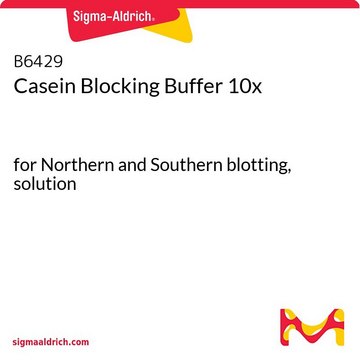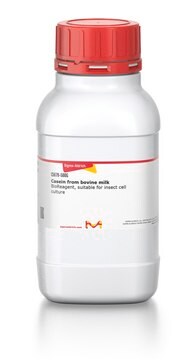Key Documents
C7594
Casein Blocking Buffer
for Northern and Southern blotting, powder blend
Synonim(y):
blocking buffer
About This Item
Polecane produkty
klasa czystości
for molecular biology
Poziom jakości
Postać
powder blend
metody
Southern blotting: suitable
pH
6.8-7.2(reconstituted per directions)
rozpuszczalność
H2O: soluble, faintly yellow (dissolves in 5-10 minutes.)
temp. przechowywania
room temp
Powiązane kategorie
Opis ogólny
Zastosowanie
Cechy i korzyści
- Better blocking performance than dried milk or BSA
- Compatible with neutral and positively-charged membranes
- Compatible with chemiluminescent, colorimetric , and DIG detection assays
Uwaga dotycząca przygotowania
produkt powiązany
Kod klasy składowania
11 - Combustible Solids
Klasa zagrożenia wodnego (WGK)
WGK 1
Certyfikaty analizy (CoA)
Poszukaj Certyfikaty analizy (CoA), wpisując numer partii/serii produktów. Numery serii i partii można znaleźć na etykiecie produktu po słowach „seria” lub „partia”.
Masz już ten produkt?
Dokumenty związane z niedawno zakupionymi produktami zostały zamieszczone w Bibliotece dokumentów.
Klienci oglądali również te produkty
Protokoły
Unoccupied sites on the solid support must be blocked to detect an immobilized antigen. This protocol describes how to use our Casein Blocking Buffer in Southern and Western blotting applications, including options for fluorescein and DIG detection systems.
Poznaj podstawy blottingu Northern i Southern, wraz z protokołami i aplikacjami do przenoszenia makrocząsteczek na nośniki membranowe.
An introduction to both Northern and Southern blotting, popular methods for the transfer of macromolecules to membranous support. This article also offers a Southern blot protocol and a northern blot protocol.
Nasz zespół naukowców ma doświadczenie we wszystkich obszarach badań, w tym w naukach przyrodniczych, materiałoznawstwie, syntezie chemicznej, chromatografii, analityce i wielu innych dziedzinach.
Skontaktuj się z zespołem ds. pomocy technicznej














